Positive Health Online
Your Country

Deep Massage: A New Step in the Evolution of Bodywork
by David Lauterstein(more info)
listed in massage, originally published in issue 240 - August 2017
The art and science of meeting through touch is what is represented in Deep Massage. It establishes a new clarity in bodywork. Equally as important, like much of the wisdom imbedded in what Aldous Huxley called “the non-verbal humanities”, it bears many precious messages for humankind.
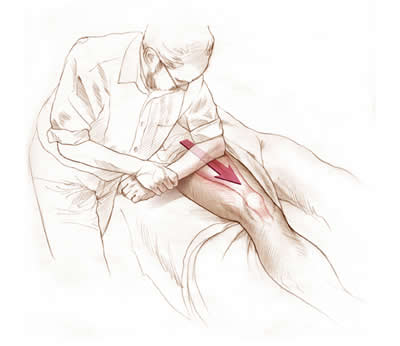
From The Deep Massage Book, © Christy Krames, Illustrator
The non-verbal humanity called bodywork may be said to begin with the acknowledgement of the importance of the body’s connective tissues, “fascia”, characterized by Ida Rolf as “the organ of structure.” Ida Rolf was the originator of “Structural Integration” whose work became well-known and influential first through her teaching at the Esalen Institute in California in the early 1970s. The observation of structural integration is that by systematically lengthening and/or repositioning the fasciae in the body, well-trained structural professionals can change clients’ posture and movement and, sometimes, emotions and thoughts that previously supported certain dysfunctional postural and movement habits.

From The Deep Massage Book, © Christy Krames, Illustrator
In turn the physical property that allowed for this change is that fascia is what is called, “thixotrophic”. Thixotrophic substances, such as certain clays in the soil, become more fluid when activity is added to them, most commonly increased pressure or movement. This is said to account for the wonderful changes people have from receiving structural bodywork. This approach also helped elevate the status of massage from being just a ‘feel-good’ rubdown to a clinically effective means to change the body’s structure and function so as to reduce pain and enhance health.
I began studying Structural Bodywork, an offshoot of Rolfing, in 1982 and took this exciting knowledge and practice into the anatomy and deep tissue massage segment at the Chicago School of Massage Therapy. However, soon something happened that began a kind of deconstruction of the ideas about what I was practising and teaching. I was talking with an acupuncturist/bodyworker, Paul Zmiewski; he described little ‘lakes’ - ventricles in the brain that were supposedly affected by cranio-sacral therapy. Being an anatomical fanatic at the time, I was intrigued with these tales of lakes and decided to look into cranio-sacral therapy as then taught by early students of John Upledger, the osteopath who expanded the teaching of cranial work to massage therapists, Rolfers, acupuncturists, and other health professionals.
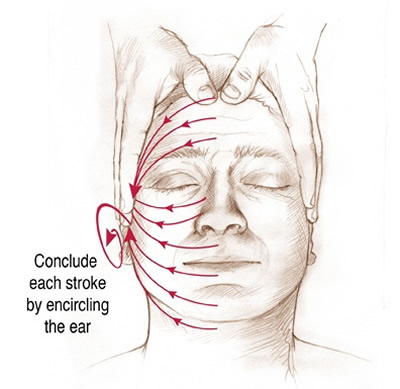
From The Deep Massage Book, © Christy Krames, Illustrator
The pressure used in cranio-sacral therapy was no more than that of a small coin on the palm. And yet, receiving the work felt so deep; it evoked a sense of fluidity deep in core of the body. Muscles felt as superficial as clothes!
When I went back to teaching ‘deep tissue’, that word no longer seemed to fit what we were doing. We affect much more than just ‘tissues’ when we work on people. So I began in 1983 to call what I was teaching “Deep Massage” rather than deep tissue, the idea being that we can affect a person deeply through all manner of touch, not necessarily only with deeper pressure, as manifest in deep tissue.
First a disclaimer: “deep tissue” well taught and practiced with sensitivity is a superb approach, as promulgated by the Rolfer Art Riggs and many others good teachers. However, early insights and recent research into pain science are modifying this model.

From The Deep Massage Book, © Christy Krames, Illustrator
What May be the Limits of the Deep Tissue Model?
- People think if light pressure is not effective, more pressure must be better – more pressure is not always the best answer;
- People think “no pain no gain” - pain is not necessarily a good thing!
- People think manual pressure into muscles and fascia change their length – muscles don’t change themselves;
- Fascia can become more fluid with increased activity, but when the activity, e.g. pressure ceases, it often returns to its original form. (By the way, you can pull a truck with an iliotibial band!)
The most important fact that calls all those beliefs into question is that your muscles and fascia do not themselves change. They do not initiate tension or relaxation anymore than lights turn on without electricity. The lengths of muscles and their associated fascia are primarily a function of the nervous system which assigns moment-to-moment muscle lengths as we stand and move. To say that a bit more simply, we may say structure responds to energy.
What difference does that then make in a bodywork which recognizes the nervous system as fundamental in giving rise to change? It brings up the question – how do we ‘touch’ the nervous system? We begin to see that our contact with fascia, muscles and other tissues is more communication than manipulation. Muscles are like cell phones with which we communicate with the nervous system.
So who and what is on the other end, what are we communicating with and what are its characteristic responses? The nervous system (aided by all other systems), houses the conscious and unconscious mind, emotions, memory, imagination, sense of body position and movement, sense of touch, etc. When we acknowledge the fact of communication through the soft tissue, then we immediately encounter the famous bodymind connection, that has been at the core of the massage movement since the 1960s. How can we optimize our communication with the nervous system through touch?
Studies have shown that the best predictor of positive clinical outcomes in psychotherapy is not the particular therapeutic approach used, but it is the relationship, the therapeutic ‘alliance’ of the client and the therapist. In education, similarly, the philosopher Martin Buber noted, “It is not the educational intention but it is the meeting which is educationally fruitful.” An important question in bodywork then is how is this alliance, the therapeutic and educational meeting, facilitated through the non-verbal medium of touch?
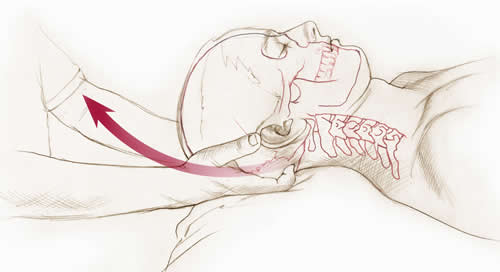
From The Deep Massage Book, © Christy Krames, Illustrator
The ideas and teaching of Deep Massage have expanded greatly since 1982, but the first principle still is at the core. It is that we need to use a bodymind tool to most effectively ‘meet’ the client and that tool is ‘the Fulcrum’. The fulcrum is defined by the American Heritage Dictionary as “the agency through, around, or by means of which, vital powers are exercised.” In Deep Massage and Zero Balancing, a fulcrum is an experience of high quality touch through which the client’s own vital self-healing powers are exercised.
For touch to be optimally effective, to meet the client, to clearly communicate just as verbal language has a grammar that facilitates meaning, the fulcrum provides a ‘grammar’ for developing rich, meaning-full connections through touch. Just as there are ‘parts of speech’, there are ‘parts of touch’ and just as each word much be distinct in diction and function, each touch for maximum effect needs to be distinct in its clarity and communication.
- The first step in touch is simple contact with no pressure. This lets the client know you are there. It is a bit like knocking on the door. It demonstrates trustworthiness not to immediately enter the body, but to let the bodymind know you are there. This is sensed by the ‘touch receptors’ lying within and just under the skin;
- To show respect for the neurological boundaries of the client one must pause at each stage of engagement, otherwise the client’s bodymind may respond with tension and/or pulling away structurally or energetically;
- The next step in the fulcrum is to press in (or add length if you are initiating a stretch) and feel for tension. The person’s nervous system now feels your engagement. You are “on” the tension. This will be sensed by the “presso-receptors” in the body. Now the therapist pauses again to let the client relax into this new level of meeting;
- Then we add additional vectors, directions, and go ‘into’ the tension. This may be adding a slight pressure, such as one does pressing into a trigger point. It may be a deep slow stroke or stretch along the length of the muscle and its fascia. In any case, now the client will ideally feel a crystal clarity of engagement with their tension. This is largely sensed by the proprioceptors in the body;
- Here duration becomes especially important. In Deep Massage, we recognize the person needs time to respond. The therapeutic process is one of dialogue, not monologue. Clients need the gift of uninterrupted time in order to let go from inside out. Relaxation and release of pain and tension are not ultimately a function of what the therapist does, they are a function of what the client does consciously and unconsciously from within themselves;
- How long shall we then hold a pressure point or work down the length of the muscle? While the client is responding to our input, the therapist needs to focus, observing for their response. So we look for a variety of objective signs of bodymind response as well as honoring our intuition to some extent. Changes in breath, facial expression, client’s reporting a positive change of sensation, certain involuntary movements, help guide us and give us a sense of ideal duration for a given fulcrum;
- Just as in any articulate sentence, the punctuation at the end lends clarity to the touch. So the end of the fulcrum is a clean, clear disconnect. After disconnecting there is again a pause, giving the client a moment or two to integrate the experience. Each touch is like throwing a pebble into a pond, watching the ripples radiate out, then letting those subside before throwing another pebble in.
Each fulcrum provides an opportunity for change. This change then constitutes a bodymind learning. The great movement therapist, Moishe Feldenkrais said, “a person can not change, unless they have a new experience.” It is the purpose of Deep Massage to, with the client’s help, create new resonant experiences through our touch fulcrums. Deep Massage is non-verbal education at its best. It is significant that in recent years Rolfers also have characterized their work as ‘somatic education’, rather than soft tissue manipulation.
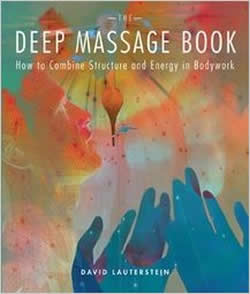
The neglect of education that is not just mentally focused is a deeply regrettable oversight of traditional education. The heart is left to its own devices, the body as well, and the spiritual realm is deemed too individual to explore together. Therefore these non-verbal humanities bear many precious messages for therapists and more broadly for humankind.
Since we are engaging the body as well as the mind, we are working more than with just the three-dimensional body. Thus, in Deep Massage, we look at seven dimensions of touch. Each of these enhances the quality of touch communication. These are core values elaborated much more thoroughly in my book, The Deep Massage Book.
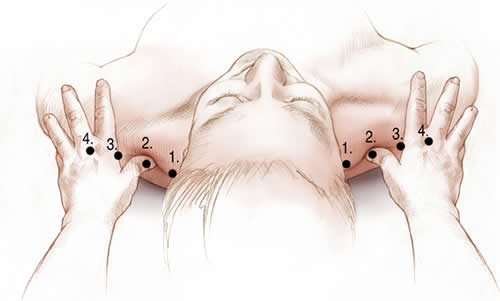
From The Deep Massage Book, © Christy Krames, Illustrator
Contact
We need to be centered in both body and mind when we touch. This means that when you lay your hand on the person’s back that you pay attention to what you are feeling - that your mind is active, not just your body. When you are present mindfully, the client will be more likely to ‘meet’ your touch with their awareness as well. Now you have a meeting of the minds not just of the bodies.
Movement
Clients respond to movement just as we respond to melody in music. You must have the muscles’ shapes and routes precisely memorized, otherwise our movement will not inspire trust. Consider the tempo of your movements; some places call for slowing way down, others can be passed through lightly and quickly. Remember the body is primarily water, so if you feel like you are up against something hard, this is a limit of your perception, not a fact. Visualizing the body as more or less dense water will make for a quality of touch when you wait for the yield, rather than trying to push through natural boundaries.
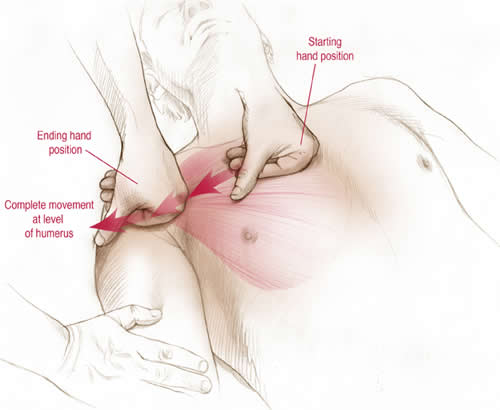
From The Deep Massage Book, © Christy Krames, Illustrator
Breath
Relaxed and full breathing adds aliveness and a gentle movement to your touch. It modifies your autonomic nervous system, giving your touch a more nurturing quality. And it non-verbally encourages the client themselves to relax their breathing. Wilhelm Reich said all neurosis involves a restriction of breathing. The opposite thankfully is true - all healing begins with a freeing of breath.
Graceful Verticality
As structural therapies have shown us, when we maintain unnecessary tension levels in the body, we have a net structural and energetic loss. Misalignment, locked joints, and rigidity all lessen our communication with the client’s nervous system. They add noise. The good news is when we work with graceful verticality, the client and the therapist feel both more grounded and more buoyant. This is one secret underlying Ida Rolf’s famous dictum, “Gravity is the therapist.” When you are manifesting grace, you will use the gravitational field of a whole planet for your pressure, not your individual force. The work then acquires an effortlessness that is extremely healthy for both client and therapist.
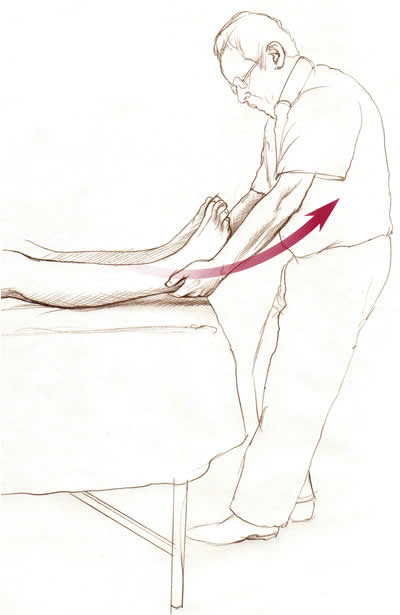
From The Deep Massage Book, © Christy Krames, Illustrator
Heart
Obviously, we are practitioners of health care. Sometimes we can overlook the power of care and love in bodywork in helping the client and therapist let go of energetic and structural restriction. Ideally every touch will be a palpable manifestation of truly caring. With heart, things open up, without, they close down. The care we feel originates in the heart and is manifest through our hands, their shape, quality, movement, pace - let us pay attention to the role of heart in ‘shaping’ our touch quality as much as the originating lungs and vocal chamber shape the sound quality of when we sing.
Understanding
The mind is as important as the body in effective work. Accessing your anatomical data banks periodically will provide greater touch clarity. Mindfully and caringly taking a history prior to the session is powerful. It enables you to begin not just caring for your client, but in each session committing to understanding them individually as best as you can. In this sense each massage is like a session of portraiture. Every painter knows how challenging it is to try to capture the essence of the person in their work. The same holds true for our attempts, but our medium is the whole person, not just paints and canvas.
Alchemy
It is thankfully not up to us, whether the client has a dramatically helpful session; we would be too powerful and inappropriate if we decided that and how they must change. However, when we refine our appreciation of our quality of contact, ease in movement, breathing aliveness, energetic and structural gracefulness, care, and dedication to understanding - then we will be working with a heightened quality of touch. In that case, the client consciously and unconsciously may feel even freer to explore their own body, mind and spirit. In that atmosphere, physical, emotional, mental and spiritual changes are more likely precipitated.
Every therapist knows there is something miraculous about touch. The study of anatomy, physiology and psychology reveals to us how miraculous is each person’s body and mind. To be human is to have a capacity for self-evolution. No other animal can in essence initiate self-growth, dramatic self-evolution in many ways in one lifetime!
By systematically using touch that recognizes and meets this miraculousness and empowers the person to let go deeply from the inside out, we are ideally empowering the person to fulfill not only their health goals, but perhaps at best, their destiny.
With the destinies of many people deeply potentiated, we can hope and work for humankind to take its history, like a thoughtful caring therapist, into its own hands.
Although attempting to bring about world peace through the internal transformation of individuals is difficult, it is the only way. --Dalai Lama
Acknowledgement
All illustrations in this article are from The Deep Massage Book, reproduced with permission from its wonderful illustrator, Christy Krames.
References
Buber, Martin. Between Man and Man. Eastford, Connecticut, 2014.
Stephens, Ralph. “Why You Can’t ‘Stretch’ a Muscle.” https://yogainternational.com/article/view/why-you-cant-stretch-a-muscle
Lauterstein, David. The Deep Massage Book: How to Combine Structure and Energy in Bodywork. Taos, New Mexico, 2012.
Ardito, Rita and Rabellino, Daniela. “Therapeutic Alliance and Outcome of Psychotherapy” www.ncbi.nlm.nih.gov/pmc/articles/PMC3198542/
Lauterstein, David. Life in the Bones: A Biography of Dr. Fritz Smith and Zero Balancing, Palm Beach Gardens, Florida, 2017.
Comments:
-
No Article Comments available